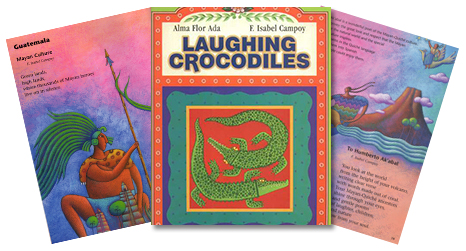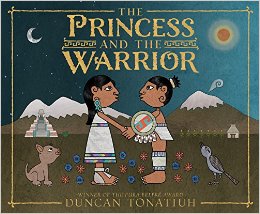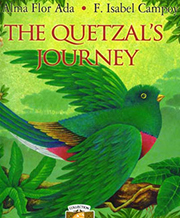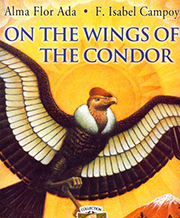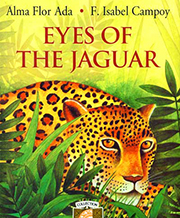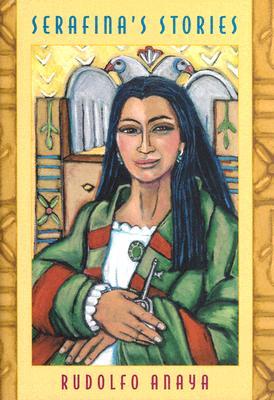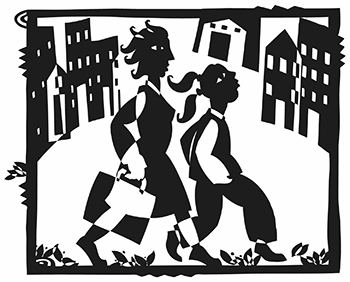
My Name is Juanita.
I am Mexican.
I live in New York.
I am Latina.
[/wc_column][wc_column size=”one-half” position=”last”]Click to see:
> Questions to initiate and guide the Creative Reading Dialogue
> Questions for the analysis of the composition and structure
of the text
> Activities students can do individually or in groups
> A creative writing Transformative Education activity
[/wc_column][/wc_row].
[wc_box color=”inverse” text_align=”left”]
Our indigenous roots are alive
Many indigenous cultures have survived. Most people in Latin American have indigenous roots.
“The children of the Americas should learn to know, respect, and love the indigenous mother
of this continent.” José Martí, La edad de oro.[/wc_box]
Questions to Initiate and Guide the Creative Reading Dialogue
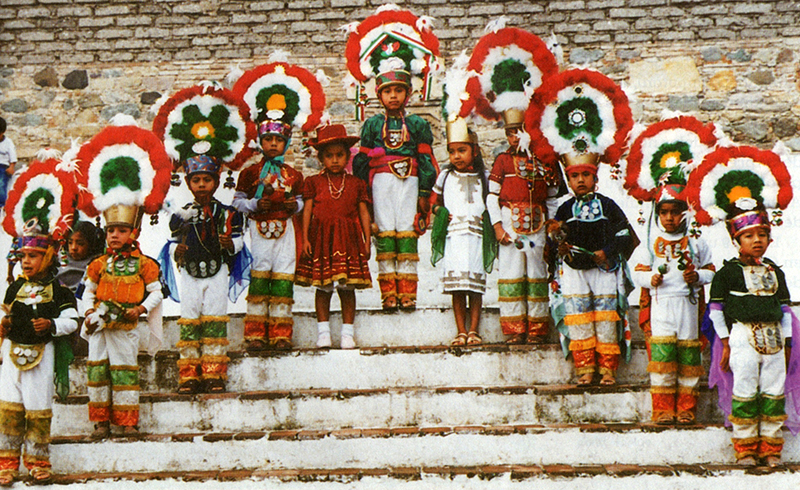
Descriptive Phase
[wc_fa icon=”arrow-right” margin_left=”” margin_right=””][/wc_fa] What do we know about Juanita’s family and about the place where she lives?
[wc_fa icon=”arrow-right” margin_left=”” margin_right=””][/wc_fa] How was Juanita’s school in her hometown?
[wc_fa icon=”arrow-right” margin_left=”” margin_right=””][/wc_fa] Why did Juanita struggle in school?
[wc_fa icon=”arrow-right” margin_left=”” margin_right=””][/wc_fa] What did Juanita wished she knew more about?
[wc_fa icon=”arrow-right” margin_left=”” margin_right=””][/wc_fa] What was the great surprise? How did it make her feel?
Personal Interpretive Phase
[wc_fa icon=”arrow-right” margin_left=”” margin_right=””][/wc_fa] Do you have indigenous roots? Do you know anyone who does?
[wc_fa icon=”arrow-right” margin_left=”” margin_right=””][/wc_fa] Do you speak at home a language other than English?
[wc_fa icon=”arrow-right” margin_left=”” margin_right=””][/wc_fa] Do you know anyone whose home language is not English?
[wc_fa icon=”arrow-right” margin_left=”” margin_right=””][/wc_fa] Have you ever moved? How did you feel about living in a different place?
Critical/Multicultural/Anti-Bias Phase
[wc_fa icon=”arrow-right” margin_left=”” margin_right=””][/wc_fa] Have you noticed anyone struggling to speak English?
[wc_fa icon=”arrow-right” margin_left=”” margin_right=””][/wc_fa] Have you seen people making fun of someone because they do not speak English fluently, or because they have a different culture or background?
[wc_fa icon=”arrow-right” margin_left=”” margin_right=””][/wc_fa] Why is it valuable to know how to speak more than one language?
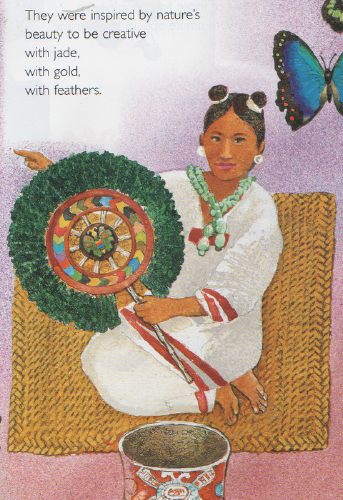
Creative/ Transformative Phase
[wc_fa icon=”arrow-right” margin_left=”” margin_right=””][/wc_fa] How is the life of people who know well more than one language enriched?
[wc_fa icon=”arrow-right” margin_left=”” margin_right=””][/wc_fa] How can we show respect and appreciation for indigenous cultures and their languages?
Questions for the Analysis of the Composition and Structure of the Text
[wc_fa icon=”arrow-right” margin_left=”” margin_right=””][/wc_fa] What words Juanita used to describe her friend?
[wc_fa icon=”arrow-right” margin_left=”” margin_right=””][/wc_fa] How does she describe her home town?
[wc_fa icon=”arrow-right” margin_left=”” margin_right=””][/wc_fa] What is the meaning of:
We smile in silence.
No explanations
to break the magic of the moment.
We have learned to smile
when we understand that silence is better…
Activities Students Can Do Individually or in Groups
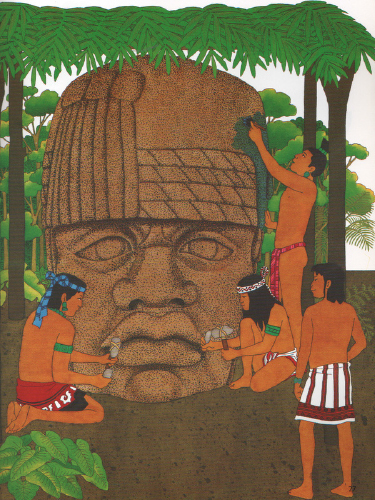
[wc_fa icon=”arrow-right” margin_left=”” margin_right=””][/wc_fa] Find/create a map showing all the countries where Spanish is spoken.
[wc_fa icon=”arrow-right” margin_left=”” margin_right=””][/wc_fa] Make a list of the countries.
[wc_fa icon=”arrow-right” margin_left=”” margin_right=””][/wc_fa] Search to find how many people speak Spanish throughout the world.
[wc_fa icon=”arrow-right” margin_left=”” margin_right=””][/wc_fa] Find out which are some of the indigenous languages that are also spoken on those countries.
[wc_fa icon=”arrow-right” margin_left=”” margin_right=””][/wc_fa] Make a display of pictures, a collage, or a mural showing monuments created by indigenous cultures
in Latin America and/or some of their art expressions.
[wc_fa icon=”arrow-right” margin_left=”” margin_right=””][/wc_fa] Have students research and share contributions of the indigenous cultures in the areas of:
[wc_fa icon=”caret-right” margin_left=”30px” margin_right=””][/wc_fa] Astronomy
[wc_fa icon=”caret-right” margin_left=”30px” margin_right=””][/wc_fa] Architecture
[wc_fa icon=”caret-right” margin_left=”30px” margin_right=””][/wc_fa] Agriculture
[wc_fa icon=”caret-right” margin_left=”30px” margin_right=””][/wc_fa] Medicine
[wc_fa icon=”caret-right” margin_left=”30px” margin_right=””][/wc_fa] Art
[wc_fa icon=”caret-right” margin_left=”30px” margin_right=””][/wc_fa] Social structures
A Creative Writing Transformative Education Activity
Students can further the exploration of their own personal identity by creating an I Am poem. This activity becomes stronger when you model it by creating a book about yourself.
[wc_row][wc_column size=”one-half” position=”first”]By Myself
Eloise Greenfield
When I am by myself
and I close my eyes
I’m a twin,
I’m a dimple in a chin
I’m a room full of toys
I’m a squeaky noise
I’m a gospel song
I’m a gong
I’m a leaf turning red
I’m a loaf of brown bread
I’m a whatever I want to be
And anything I care to be
And when I open my eyes
What I want to be
Is me.
Uniqueness
F. Isabel Campoy
I am a woman, creator of life.
I am Latina, passionate, familiar.
I am an emigrant,
conscious of my two horizons.
I am bilingual,
capable of negotiating contradictions.
I am the granddaughter of peasants.
I am the daughter of tenacity and love.
I am mestiza of cultures, of races,
of ways to see life.
I am a voice without fear.
I am here, building new roads
to go forward,
true to myself.
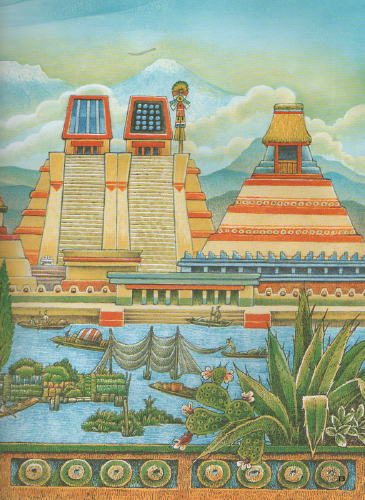
1. Create your own “I Am” book
[wc_fa icon=”arrow-right” margin_left=”” margin_right=””][/wc_fa] Metaphoric “I Am” book
—-Present yourself in terms of:
[wc_fa icon=”caret-right” margin_left=”30px” margin_right=””][/wc_fa] colors, fragrances, feelings, food, music, songs, etc.
[wc_fa icon=”caret-right” margin_left=”30px” margin_right=””][/wc_fa] a part of nature: ocean, mountains, desert, fields, trees, or flowers, animals, birds, fish
[wc_fa icon=”caret-right” margin_left=”30px” margin_right=””][/wc_fa] a place or object in your house, an element of your life
[wc_fa icon=”caret-right” margin_left=”30px” margin_right=””][/wc_fa] a cultural icon
[wc_fa icon=”caret-right” margin_left=”30px” margin_right=””][/wc_fa] any image that represents you
[wc_fa icon=”arrow-right” margin_left=”” margin_right=””][/wc_fa] Relationship “I Am” book
[wc_fa icon=”caret-right” margin_left=”30px” margin_right=””][/wc_fa] Present yourself as daughter/son; sister/brother; aunt/uncle, etc.
[wc_fa icon=”arrow-right” margin_left=”” margin_right=””][/wc_fa] Acrostic “I Am” book
[wc_fa icon=”caret-right” margin_left=”30px” margin_right=””][/wc_fa] Use each letter of your name to guide the structure of the book
[wc_fa icon=”arrow-right” margin_left=”” margin_right=””][/wc_fa] Combination or Original structure “I Am” book
[wc_fa icon=”caret-right” margin_left=”30px” margin_right=””][/wc_fa] Dare to be creative.
2. Create a collective “I Am” poem with the class
[wc_fa icon=”arrow-right” margin_left=”30px” margin_right=””][/wc_fa] Share your poem with the students and ask each one to give you one sentence to create a collective poem.
3. Encourage students to create their own individual poems
4. Create a class book
[wc_fa icon=”arrow-right” margin_left=”30px” margin_right=””][/wc_fa] Include your poem, the students’ collective poem and their individual poems.
5. Share the class book with parents
6. Invite parents to create their own poems
7. Create a parents collective books for the classroom, school and public libraries.
The Transformative Education Principles supporting these activities and the methodology of Authors in the Classroom can be found in www.authorsintheclassroom.com
Specific examples of I Am Books can be found at: http://authorsintheclassroom.com/1-affirming-self-i-am-books/
Visual activities
Take advantage of quality sites in the Internet to provide valuable visual experiences for your students.
The Smithsonian Institute has a virtual exhibition: http://latino.si.edu/exhibitions/centralamericarevealed/3DSim/RACA.pdf
Related Books Grades 2-4
.
[wc_row][wc_column size=”one-fourth” position=”first”]
Laughing Crocodiles by Alma Flor Ada & F. Isabel Campoy.
Includes Guatemala section with poems by Humberto Ak’abal
The Princess and the Warrior by Duncan Tonatiuh
[/wc_column][wc_column size=”one-fourth”] How Chile Came to New Mexico by Rudolfo Anaya
How Chile Came to New Mexico by Rudolfo Anaya
 The Golden Flower: A Taíno Myth from Puerto Rico by Nina Jaffe
The Golden Flower: A Taíno Myth from Puerto Rico by Nina Jaffe
Related Books Grades 4-8
.
[wc_row][wc_column size=”one-fourth” position=”first”]
The Quetzal’s Journey by Alma Flor Ada & F. Isabel Campoy
[/wc_column][wc_column size=”one-fourth”]On the Condors’s Wings by Alma Flor Ada & F. Isabel Campoy
[/wc_column][wc_column size=”one-fourth”]Eyes of the Jaguar by Alma Flor Ada & F. Isabel Campoy
[/wc_column][wc_column size=”one-fourth” position=”last”] [/wc_column][/wc_row]
